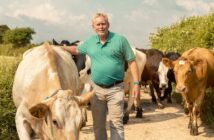Farmers seeking spring cropping options but wary of crops which could cause them harvest hassles should reconsider combining peas, in the light of the addition of a new large blue variety to the PGRO Recommended List, which offers not only top yield, but also sets a new benchmark for standing power.
That’s according to Lincs-based merchant Dunns, which believes the latter trait in particular means Campus, from LS Plant Breeders Ltd (LSPB), could change the way in which farmers view the crop.
“The market for dry peas is set to rise, with the feed industry saying they want continuity of supply,” believes Peter Busfield, of international seed and pulse processors Dunns.
“Improved levels of supply could, in turn, increase the likelihood of ration inclusions, and are therefore likely to increase the stability of the dry pea market.”
“There are also significant market opportunities for large blue types in the packet trade, for canning, for micronising and for export, so the crop is particularly versatile. But the seed trade appreciates that what farmers also need is something they can be sure will produce decent quantities of a quality sample and, in particular, be easy to harvest.
“That’s where I think Campus is different. It offers the joint-highest yield potential of any combining pea on the PGRO Recommended List, and provides a sample with a higher protein content.”
The variety also produces a sample with good colour retention, a characteristic that’s particularly important for the added-value markets, notes Mr Busfield.
“But just as essentially, it’s easy to combine. There’s no point in a variety that produces good yields of quality peas if they have to be picked off the ground. Despite being a relatively tall variety, Campus has a rating of 8 for standing ability at harvest. The longer straw aids drought resistance, which is useful on lighter land and in drier summers. It’s also early to ripen, which will aid harvest planning – in most years Campus will be cut before the wheat harvest starts. This is a great help in spreading the harvest workload. Resistance to pea wilt and to downy mildew complete a good agronomic package.”
It’s that strong standing ability, though, which could be a game-changer for the way farmers view peas, he suggests.
“We’ve already sold a lot of seed for the coming spring, and I think interest is likely to grow as farmers seek spring crops that not only offer the promise of good yields but also fit in well with harvest plans and can be combined with the minimum of fuss.”
Picture shows Peter Busfield, of international seed and pulse processors Dunns (IN CENTRE), with Harrison brothers who farm as DW Harrison at Woodhall Spa and are long established seed pulse growers.



